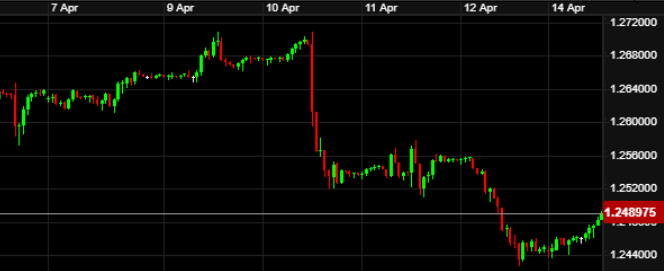ACM Update 15-04-24

The UK economy grew (again), the European Central Bank moved silently closer to a rate cut and US inflation ran hotter than forecast. A hectic second half of last week saw over 2% movement on Sterling-Dollar in little more than 48 hours, pushing the pair to its lowest level since mid-November.
This week sees the release of March’s inflation data from the UK, as well as the same figure in Europe. Given last week’s US inflation figure, a hefty drop for the metric in the UK and Europe could well see the respective currencies lose further ground, based on growing expectations for rate cuts.
Starting off in the UK, it was good to see the UK economy continuing the positive start to 2024. GDP figures for February, released on Friday morning, showed a monthly growth of 0.1%. This was broadly attributed to manufacturing and production industries, which themselves grew by 1.1% in the month.
The figures also revised the January reading from 0.2% to 0.3% growth, providing the biggest monthly growth in GDP since June of last year (the month after the Coronation). Such data provides hope that the economy might already be out of a technical recession in Q1. A short and shallow recession was predicted, which seems to be accurate.
In other buoyant news, the retail sales sector seems to be performing well too. Tuesday morning saw the release of the British Retail Consortium’s retail sales monitor. This metric measures the change in the value of same-store sales from one year to the next, and reported a growth of 3.2% from March 2023 to March 2024. Definitely good news for the high street.
There were speeches from a couple of different members of the Bank of England’s nine-strong Monetary Policy Committee last week. Perhaps the most significant was independent Megan Greene giving her thoughts on interest rates for the remainder of the year. She argued that investors are wrong to bet on early rate cuts and that such a move “should still be a way off”.
The latest expectation is that markets are pricing in two interest rate cuts in the UK for 2024, with the first now nudged back to the August meeting. At the turn of the year, six cuts were expected. With interest rates forecast to stay higher, combined with growth and retail sales data performing well, we saw a positive picture for sterling against the Euro. The pair nudged to its best in three weeks, as shown in the chart below.

On the European side of the coin, the ECB held their latest meeting last week. This had been expected to be the appetiser for the June meeting, where Lagarde and her colleagues may move to cut interest rates. For this meeting, a Bloomberg poll suggested just one of sixty-two economists surveyed thought there would be an interest rate cut last week, and indeed the sixty-one proved to be correct.
Expectation was high though that Lagarde would answer some “burning questions” in her press conference, but the result couldn’t have been further from that. The pressing topics were:
- Will the ECB look to cut rates in June?
- Does rising inflation in the US impact the path for the ECB?
- Will a strong Dollar and a weak Euro cause further inflationary concerns?
On all of the above, Lagarde remained tight-lipped, offering very little in the way of reassurance or information. Simply stating (as has been the case for months) that any rate decision will be data-driven, and that activity in the US does not impact their policy. She also noted the ECB does not target a particular exchange rate and does not intend to.
All in all, markets were not comforted by the ECB President’s comments, which saw the Euro lose value against sterling, but considerably so against the Dollar. Various articles suggested that some members of the rate-setting committee had been keen to look at a rate cut in this meeting, however the consensus eventually moved to a decision to hold.
If the ECB are moving towards a rate cut, their approach to it is somewhat stealthy and they aren’t giving any clues as to when it may happen. Financial markets still forecast four interest rate cuts in Europe for 2024, but when they will start remains a mystery. From a data perspective, it does feel that the ECB may be the first to cut rates of the big three. But the inflation releases of this week may influence that.
Aside from the relative silence from the ECB meeting, there was little European data. German and French CPI figures for March were released on Friday morning, coming in at 0.4% and 0.2% month on month growth respectively, as the German economy continues to struggle.
Over in the US, it was a massive week for the Dollar, gaining over 2% against GBP and the Euro in as little as 48 hours to close out the week. The move saw GBP-USD head to its lowest since 17th November last year, and EUR-USD to its lowest since 3rd November.
The shift started on Wednesday lunchtime with the eagerly awaited March CPI inflation data. February had seen the metric at 3.2%, but the March release bounced back up to 3.5% thanks to fuel prices and sky-high mortgage rates. US inflation is really remaining sticky, and in fact Core CPI has now risen at an annualised rate of 4.6% over the last three months. According to the statistics, this is faster than any period between mid-1991 to the start of the COVID pandemic.
The move signals even more confidently that the Federal Reserve’s headline interest rate will remain higher for much longer. As with the ECB, circa six interest rate cuts for 2024 were previously expected, but that number could now be anything from one to three, depending on who you listen to.
Former Fed member James Bullard commented last week that he expects to see three interest rate cuts this year. Current market expectations are for two rate cuts to be the norm, given the strong US jobs data for March, a strong economy and inflation remaining stubborn. Current Fed member Raphael Bostic though, continues to reaffirm his belief that just one interest cut can be expected this year. Believe who you will!
The other Dollar-driver this week was the release of the minutes from the latest Federal Reserve meeting, held on the 20th March. These were circulated on Wednesday evening and showed the committee (overall) wants to be more confident that inflation is moving towards their 2% target, before taking policy action.
Given the bounce back in inflation in March, this does seem to be the sensible approach for now. As with the ECB, the lengthy discussion cited the geopolitical situation and rising energy prices as major concerns, that could lead to inflation ticking higher.
In terms of other central banks, we saw interest rates held by the Reserve Bank of New Zealand and the Bank of Canada last week. The former held rates at 5.50% for the sixth consecutive meeting, whilst the latter remained at 5.00% for the same number of meetings.
A very volatile week as mentioned on GBP-USD as illustrated in the chart below:

The week ahead:
Monday – MPC Breeden speech (12:15 UK time), US Retail Sales (13:30)
Tuesday – UK Unemployment & Claimant Count (07:00), Canada CPI Inflation (13:30), BoE Andrew Bailey speech (18:00), Fed Jerome Powell speech (18:15)
Wednesday – UK CPI inflation exp 3.1% (07:00). Eurozone Final CPI inflation exp 2.4% (10:00), MPC Greene speech (13:05), BoE Andrew Bailey speech (17:00), Fed Mester speech (22:30)
Thursday – Australian Unemployment (02:30), US Unemployment Claims (13:30)
Friday – UK Retail Sales (07:00), MPC Breeden & Ramsden speeches (15:15), MPC Mann speech (17:30)
A very busy week last week demonstrating what can easily happen in the foreign exchange markets. Movements of 2% plus are very much possible in a week and can implicate property purchases for individuals and invoice payments for businesses alike. The escalating geopolitical situation over the weekend in the Middle East will not help either.
Recent USD data seems to suggest (for now at least) that US interest rates aren’t going to come down any time soon. We have gone from an expected six interest rate cuts from the Fed in 2024, down to anywhere between one and three, as already mentioned. That is currently supporting the Dollar hugely as the Federal Reserve have no need to cut due to how well the US economy is performing.
On this side of the Atlantic, UK growth is better but still sluggish and inflation is coming down. Whichever of the ECB or Bank of England blinks first, will likely have a negative impact on their currency. Currently, the ECB look like the most likely candidate to take the plunge.
A busy week of UK data to come with the March Unemployment, Inflation and retail Sales numbers dotted throughout the week. This combined with speeches from Andrew Bailey at an event in Washington, as well as from numerous other MPC colleagues, should lead to some Sterling movement. As always, the data and content of their speeches will be the drivers.
Having seen such swings last week, there is always the possibility for the same to come. Should you have any pending payments, which you want to remove your FX risk from, make sure to reach out to the team for more information on solutions.
Have a great week.